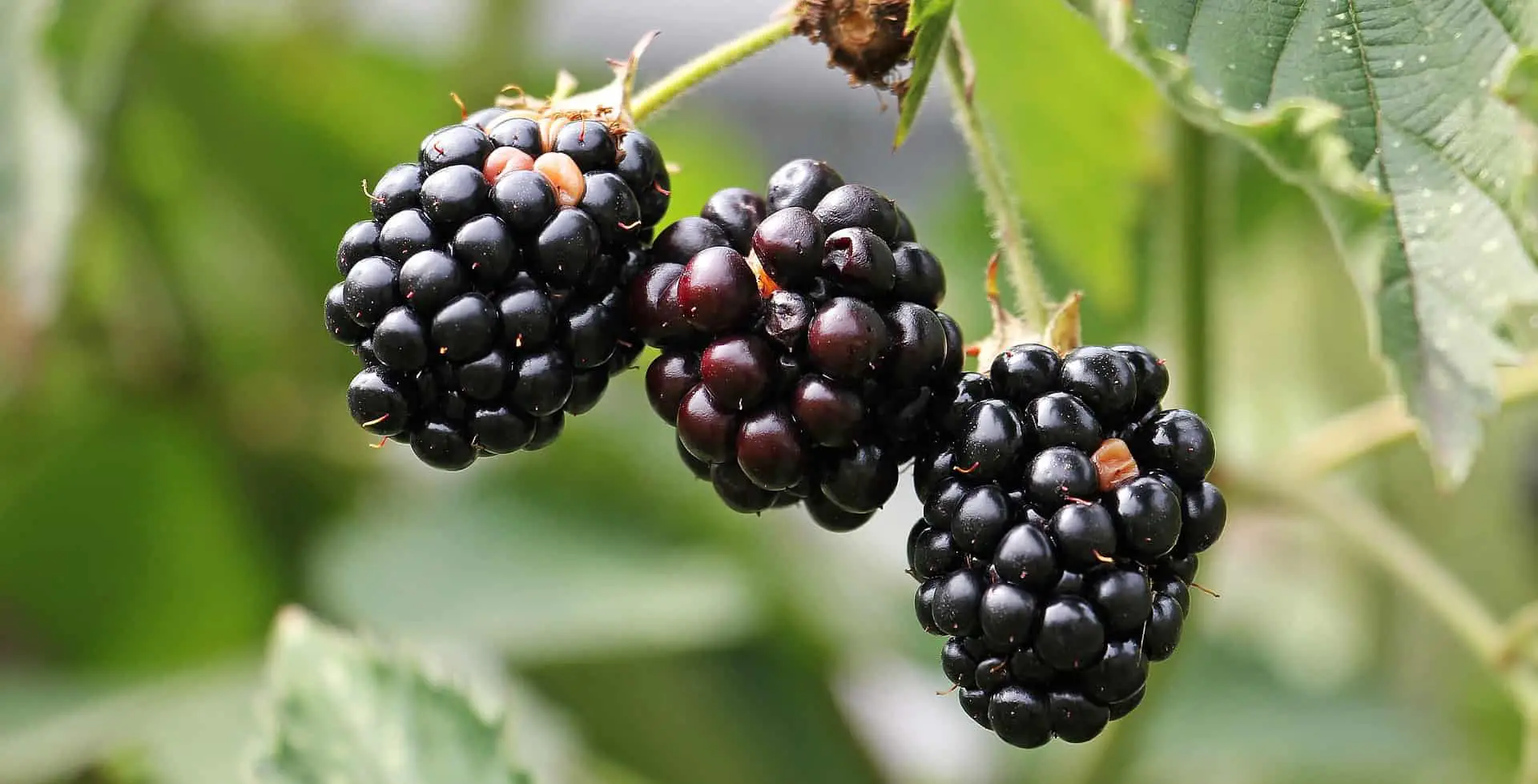The state of Arkansas has mild winters and humid summers, making this state a great place for wild berries to grow. Besides wild berries, you’ll also find plenty of wild apple trees, pear trees, and mushrooms growing throughout the state. Many of the wild berries you’ll find here are edible. This is true of familiar finds, like wild blackberries or edible berries that may be less familiar. Examples include treasures like sumac berries, beauty berries, and juniper berries.
It’s important to note that there are also poisonous berries in Arkansas. Familiarizing yourself with pokeberry and avoiding eating it can help you safely enjoy the wild edible fruit you’ll find on the trail here.
In this blog post, we’ll explore the types of wild berries you can find and eat in Arkansas, along with essential information on finding, identifying, and enjoying your spoils.
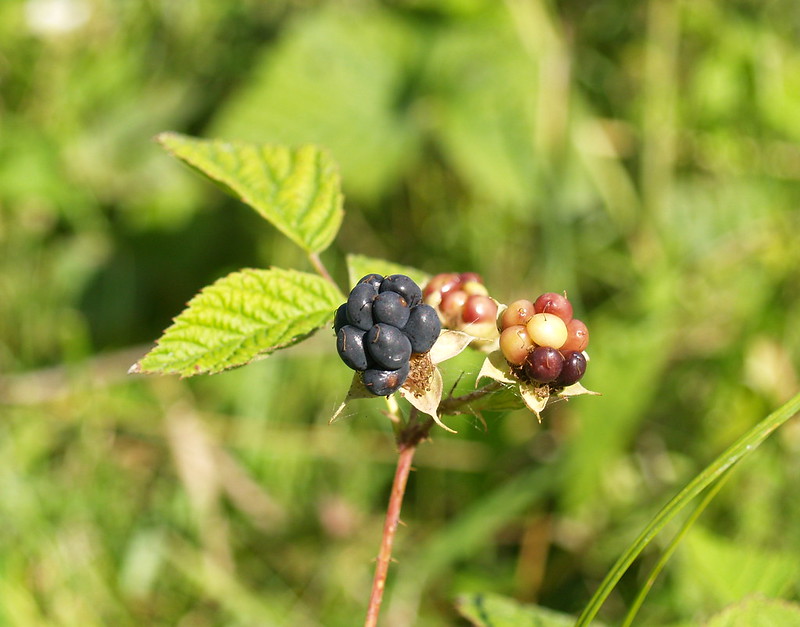
Dewberries (Rubus trivialis)
Dewberries thrive in open fields, along roadsides, and in sunny, well-drained locations throughout Arkansas. Dewberries resemble blackberries but have trailing vines and produce fruit in clusters.
You can start looking for the fruit as early as late May, some years. Mostly, you’ll find ripe dewberries in mid-June through July.
Dewberries don’t just look like blackberries; they taste like them too. They are tart, intense, and delicious. Some people enjoy eating tart berries fresh. Others prefer their dewberries sweetened a bit. If you’re in this camp, try using your dewberries to make a cobbler, jam, syrup, or as a topping for ice cream.
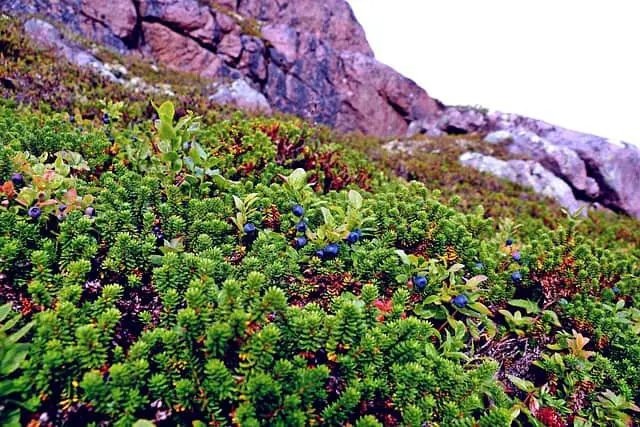
Wild Blueberries (Vaccinium spp.)
These Late Lowbush Blueberries (vaccinium pallidum) are often found in the Ozark and Ouachita regions, favoring acidic soils. Lowbush blueberries are small, round, and blue-purple when ripe.
The blueberries you are likely to purchase at grocery stores are highbush blueberries. They are larger than the lowbush blueberry. The lowbush blueberry is sweeter and grows closer to the ground.
Later summer is the prime time for blueberry picking in Arkansas. Fresh blueberries are delightful, but they also make excellent additions to pancakes, muffins, or ice cream.
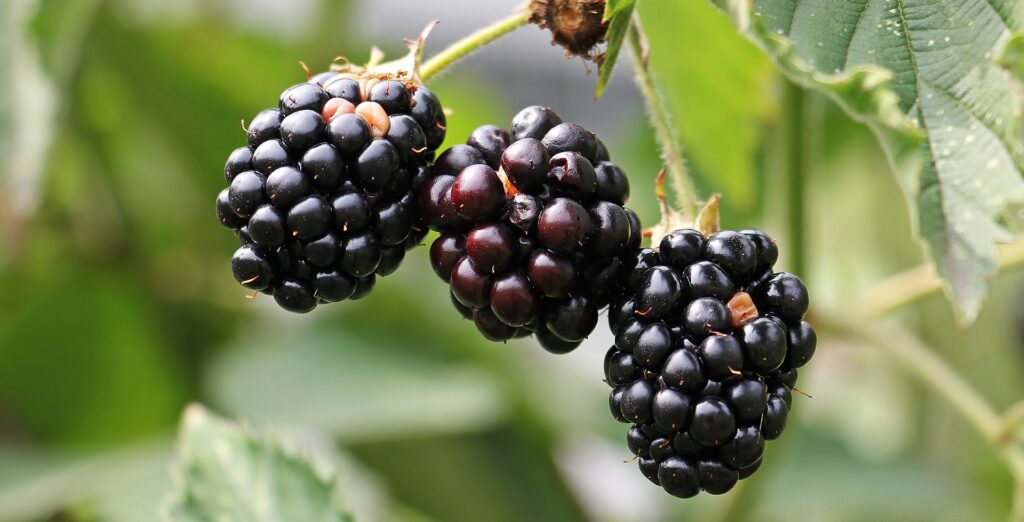
Wild Blackberries (Rubus spp.)
Blackberry plants are abundant across the state, thriving in various habitats. It’s common to find blackberry bushes growing near lowbush blueberries, so if you find one, keep an eye out for the other.
Look for dark, plump, and glossy berries with a slightly sweet aroma. Wild blackberries do look and taste similar to what you find at the grocery store, so you are likely familiar enough to feel confident identifying the common blackberry. Be aware that this confidence can be misleading, and you should still take the time to use two field guides, look at the vines, identify the leaves, and give the berries a thorough examination before you eat a new plant. Wild edible plants are easily confused, especially when they look similar.
In the early spring, you’ll spot white flowers. You’ll start seeing shiny fruit appear in July and August. Be mindful of the thorns on the vines when blackberry picking. It may be useful to wear full-length jeans and gloves and carry scissors to clip back long vines. Blackberries can be enjoyed fresh off the vine, or you may use them in jams or pies.
According to this publication from the University of Arkansas Agricultural Division. Blackberries tend to turn fully black before they are ripe. You should choose fruits that are firm to the touch.
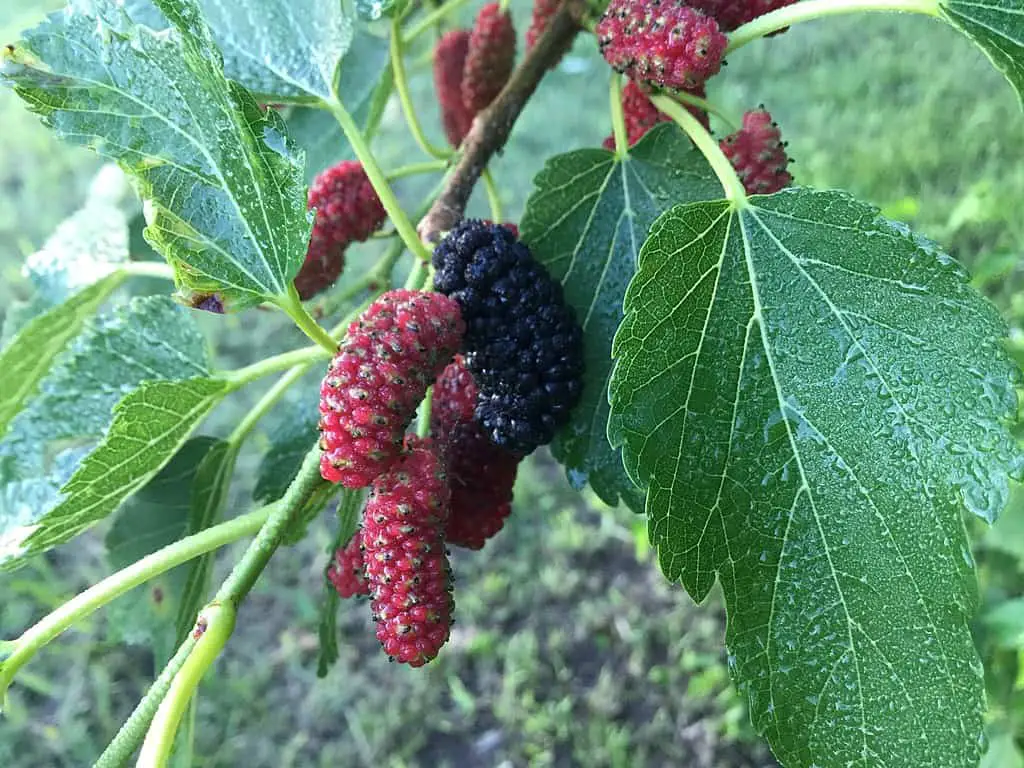
Mulberries (Morus spp.)
Mulberry trees can be found throughout Arkansas, often near rivers or in open fields. Mulberries are purple-black when ripe and grow on deciduous trees. They are incredibly juicy and will likely stain your fingers as you pick them. You’ll want to pull them from the tree as gently as possible.
You can harvest mulberries in mid-summer, often in June through August. They taste very sweet and juicy and are nearly black in color when ripe. Eat them fresh or use them in pies, tarts, or ice cream.
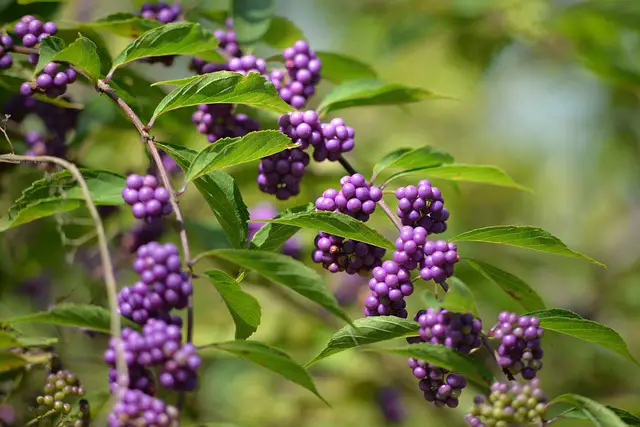
Beauty Berries (Callicarpa americana)
Beauty berry bushes are common in wooded areas and along forest edges in Arkansas. These berries are vibrant purple and grow in clusters. Their unique coloring is striking and part of what gives them the “beauty” part of their name. Once you’ve seen beautyberries, you’ll have an easier time recognizing them in the future. They’re hard to miss once you know them.
American beauty berries are different from the Asian variety. Asian beauty berries ripen in the middle of summer. The beauty berries in North America will be ready for harvest in October.
While they are not typically eaten fresh, beauty berries can be used to make jellies, syrups, or infusions for ice cream. It can be difficult to explain what these berries taste like because their flavor is so unique. In fact, their unique flavor and unique aesthetic combine to make them quite popular. They have a mildly sweet flavor that’s somewhat spicy and aromatic. Once you’ve had one, they’ll be hard to mix up with other types of fruit.

Wild Raspberries
Both red and black wild Raspberry plants grow throughout Arkansas. They typically grow in dense thickets in areas with plenty of sunlight and can often be found along the edges of fields, in hedgerows, or in other areas with ample sunlight.
Wild raspberries are identified by their small, delicate, red or black berries that grow in clusters. With a little patience and a keen eye, you can easily find and enjoy the sweet and tangy taste of fresh, wild raspberries.
The window for finding wild raspberries in Arkansas is fairly brief. You’ll want to start looking in late June. The season lasts through the middle of July.
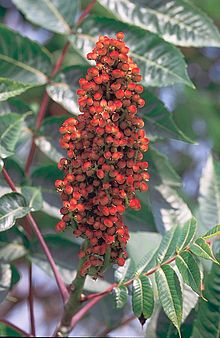

Smooth Sumac (Rhus glabra)
Sumac bushes are commonly found in open areas, particularly in the Ozarks. There are a few types of sumac growing in Arkansas. While many people have been warned to avoid “sumac” because of its poisonous leaves, there are also sumac plants that are safe and grow edible berries. Smooth Sumac (Rhus glabra) is a great example. This shrub will have yellow flowers in the height of the humid Arkansas summer. Later, the fall will turn the leaves red. Following this, the plant will grow red berries, waiting to be collected and enjoyed. These sumac berries have a tart flavor that is often described as lemony.

Elderberries (Sambucus spp.)
Elderberry bushes thrive along riverbanks and in moist areas. Elderberries are dark purple and grow in umbrella-like clusters. Late summer is the best time to harvest elderberries. Look for them in mid-August.
Elderberries can be used to make jams or syrups. To avoid an upset stomach, you should always cook your elderberries before eating them.
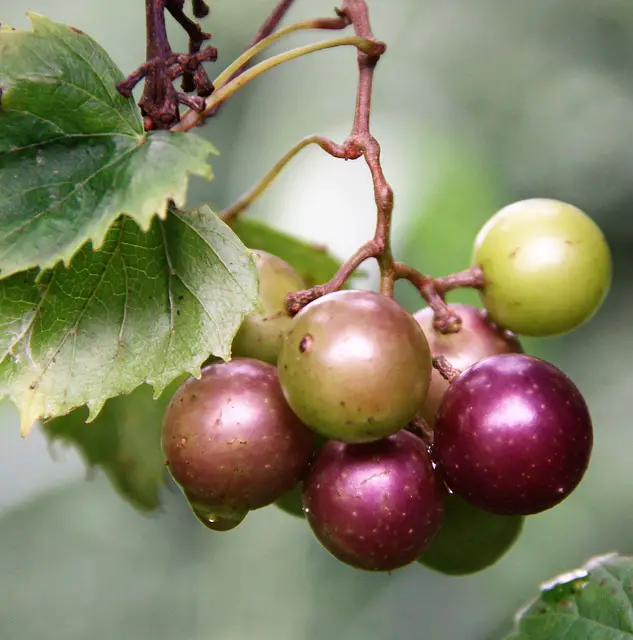
Muscadine Grapes (Vitis rotundifolia)
Muscadine vines flourish in the southern part of the state. You can pick this ripe fruit in August and September in Arkansas.
You’ll recognize muscadine with its heart-shaped leaves. The young leaves can be cooked until soft in hot water and eaten, or they can be used to wrap other foods. They flower in early spring, forming clusters of small greenish-yellow flowers. The berries are bigger than the grapes you’re used to seeing at the grocery store. They have seeds and thick skin, which some people may be turned off by. But the skins are full of dietary fiber and antioxidants that can help protect against cholesterol and heart disease. They come in different colors, from bronze to purple, while wild grapes may stay green through maturity.
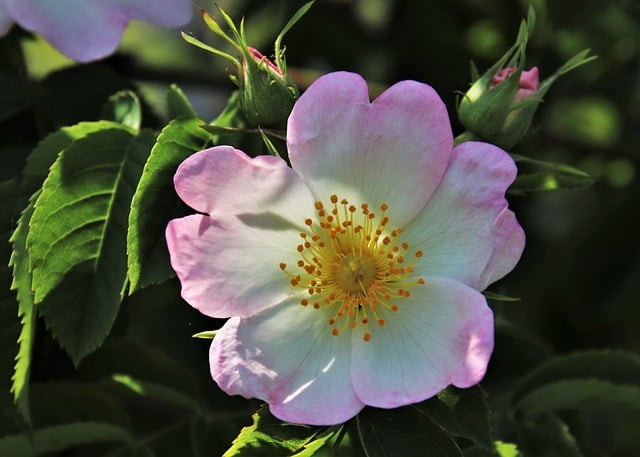

Wild Rose Hips (Rosa spp.)
After the beautiful blooms of spring, wild roses produce rose hips, which are small, round, and red or orange in color. These wild fruits are sometimes called rose berries. These berries are packed with vitamin C and antioxidants. They are a powerhouse berry known for promoting good health, which makes them particularly popular with foragers. The berries can be gathered in late summer or early autumn when you’ll be competing with local wildlife for the delicious fruit. Wild rose hips make excellent additions to teas, syrups, and jams.
Rose hips are good for your immune system because they are high in vitamin C and phenolic and flavonoid antioxidants.
The wild rose varieties native to Arkansas include the prairie rose and the Arkansas rose. You’ll see them growing with delicate pink or white flowers earlier in the year. You’ll recognize the prickly stems that roses are known for. Due to those thorns, you’ll want to bring some tools with you when you go to pick their red berries. Bring along some gloves and clippers when you decide to harvest rose hips.
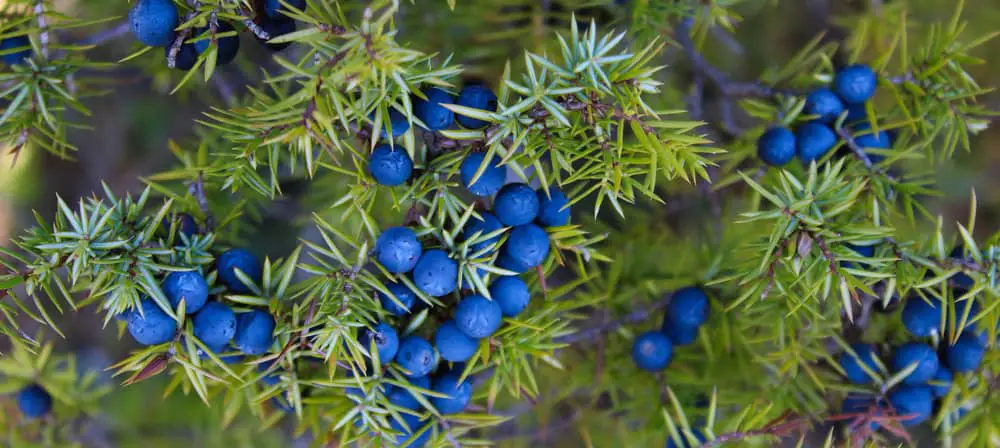
Juniper Berries
Juniper berries are not actually berries but are female seed cones that have a berry-like appearance.
Juniper berries can be found in the Ozark and Ouachita Mountains, particularly in areas with well-drained, rocky soils. Look for small, bluish-black berries with a fresh, piney aroma. These berries are often used to season savory dishes. Juniper berries are a great addition to many meat recipes. More famously, juniper berries are the flavoring for gin.
Most of the time, foragers find their favorite foods in the later summer months. Juniper berries are a fun Arkansas find because you can look for these wild berries in the later winter months.
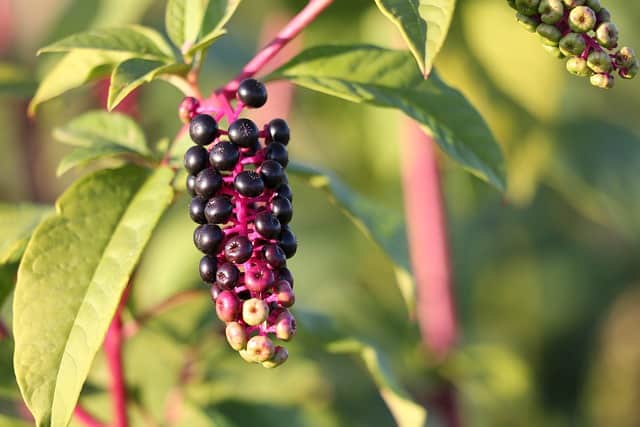
Caution: Avoid Pokeberry
While Arkansas offers plenty of wild berries to explore, it’s crucial to be aware of poisonous plants like the pokeberry bush. These berries have a deep historical presence in Arkansas, often used for their medicinal properties. However, they are highly toxic and cannot be consumed. Eating just ten pokeberries can be fatal for an adult human.
Identifying pokeberries is essential to avoid accidental ingestion. Once you’ve seen a pokeberry bush or two, it should be easy to identify them in the future. Note that many people will try to say they are edible or feel tempted simply because they look pretty and juicy. You may see animals eating them. However, these purple-black berries can be deadly, so please use caution, especially when you’re foraging for wild berries and bringing children along with you.
Pokeberies grow on tall, herbaceous plants with distinctive clusters of dark purple-black berries. Always exercise caution when foraging and consult a skilled practitioner or reference guide when unsure about the edibility of wild plants.
Arkansas is Rich With Wild, Edible Plants
Arkansas, with its diverse landscape and long growing season, provides an abundance of wild berries for foragers to explore. Whether you’re picking wild blackberries in the height of a hot Arkansas summer or climbing through the woods in the winter looking for the evergreen juniper berries, there’s always fresh fruit to enjoy.
While you can definitely head out on the trail and find lots of wild edible plants in Arkansas, keep in mind that there are also family farms with u-pick opportunities across the state. This can be a great way to get familiar with picking fresh plants and correctly identifying them in a safe environment. Of course, you can also find many of these edible berries at your local farmer’s market.
When you do head out to forage for fresh wild food, remember to avoid pokeberry bushes and prioritize safety when foraging for these delectable, wild edibles.
Gear up, possibly with long pants and long sleeves to avoid blackberry thorns, grab a bucket for berry harvesting, and head outdoors to discover the rich tapestry of flavors Arkansas has to offer.
Recent Posts
The only venomous snakes in Washington State are Northern Pacific Rattlesnakes. The Northern Pacific Rattlesnake (Crotalus oreganus oreganus) is a sub-species of the Western Rattlesnake. Anyone...
Skunks are not classified as true hibernators. But they go into a state of torpor when the weather gets cold. Skunks are light sleep hibernators, along with opossums, bears, and raccoons. ...

